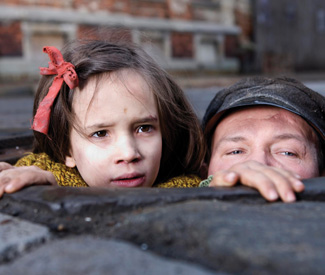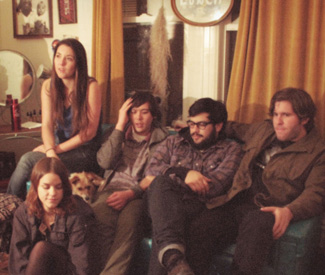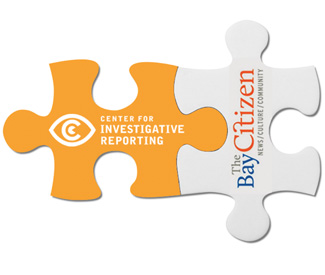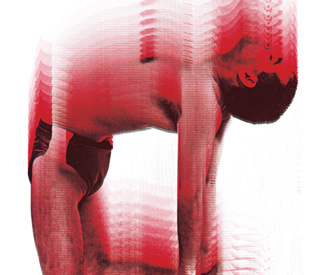culture@sfbg.com
YOGA For a sizeable sector of our population, yoga is as much a part of the culture as burritos and biking to work. With more than 50 studios in San Francisco’s 49 square miles alone — and even a brand-new yoga room in SFO, which claims to be an airport first — the Bay Area isn’t short on options for a Saturday morning sweat sesh or Sunday night candlelight.
But which teacher is best for you? For three exhaustive weeks I pretzeled it up from Berkeley to Bernal, sampling classes with some of our most famous and intriguing yogis. Below are my experiences with each, along with a one-to-five “sweat factor” intensity rating . Hopefully, this will help you choose the right teacher to help you lighten up, ground down, or just plain bliss out. (Perhaps you might be inspired to follow one of our dozens of other local yogis’ paths.)
Me? I’ll be soaking in a hot bath. Can you hand me that ice pack?
PETE GUINOSSO: GOOFY AND LOOSE
If you’re the kind of person who thinks the Black Eyed Peas and Beyoncé — let alone House of Pain — don’t belong in the yoga studio, then Pete’s Friday night Happy Hour Yoga at Yoga Tree on Valencia (www.yogatreesf.com) isn’t for you.
Guinosso breaks it down, both musically and with frequent stops to explain a new inversion or variation on an arm balance. With plenty of “play time” to work at your own pace, plus friendly gossip and occasionally flirty energy in the female-heavy room, the class can sometimes feel more like a very sweaty cocktail party. But it’s a great way to stay loose, learn new tricks, and cultivate what Pete calls the “inner teacher.” The smiley, Forrest-trained yogi also guides more traditional vinyasa and candlelight flow classes — no Top 40 here — but his liberating sense of humor remains.
Sweat Factor: 3
The Takeaway: Fun and funky, but probably not best if verses from “Afternoon Delight” aren’t among your favored mantras.
www.petegyoga.com
LES LEVENTHAL: FRESH AND AFFIRMING
Imagine taking a rubber band ball and chucking it down some hard wooden stairs: that’s what Les was like, bouncing around during Saturday morning vinyasa while his students were still waking up.
But that’s all right. As my neighbor one mat over put it, Les is “really good at letting you know that where you are is fine, while at the same time pushing you to move forward.”
Leventhal’s quirky style, coupled with live beats by Sac-town sacred sound messenger Nate Spross (Les has also brought the likes of Buddha Bar’s Daniel Masson from Paris to spin), kept class sparkling; even when he got down among the mats to demonstrate a Foot-Behind-Head pose which morphed into a series of arm balances that had students’ eyes bulging, his sense of humor soothed the spirits of those of us who were in pain just watching — let alone trying to replicate the seamless flow.
“Why do we let our heads tell us what’s good enough?” he asked, putting a hand at neck level to show a separation between head and body. “Even if you’re in the simplest expression of this pose, it feels good from here down!”
Sweat Factor: 4
The Takeaway: Down-to-earth, despite chanting in a reverberating baritone that brings me shuddering back to the rabbis of my Sunday school days.
www.yogawithles.com
JANET STONE: FAST AND UNFETTERED
With barely two inches between mats on a Saturday morning, it’s easy to see that Janet is a Bay Area favorite. She’s no slave to typical maneuvers like the Sun Salutation, though, and while her fast flows kept class interesting, all the unfamiliar iterations seemed a bit frantic — and made the class more about momentum (and not getting lost) than about muscle and alignment.
But of course, that’s the yoga. And though her students may love her because they come to learn her style, she might say the real work is in getting better at not knowing what’s next. Or, in Janet’s wording: “In this practice we pause and disarm our myriad of defenses, and experience the pure luminous light that is there.”
Sweat Factor: 3
The Takeaway: Good if you like spontaneous Hare Krishna-themed dance fevers and Lulu-clad students eager to show off their handstands — even when that means toppling onto others’ mats.
www.janetstoneyoga.com
RUSTY WELLS: DEVOTED AND UNDONE
Only a few years after beginning his journey as a yogi in early 1990s Atlanta, Rusty started to sense something missing.
“A teacher of mine told me after class one day, ‘it looks like you’re praying when you practice,'” Rusty says, “and my reply was, ‘What, am I not supposed to be?'”
Now he knows that something is bhakti, Sanskrit for “devotion to the wonder of life,” and it’s for sale (well, actually, for donation) at Rusty’s vinyasa-inspired studio near the Mission, Urban Flow (www.urbanflowyoga.com).
Taking class with Rusty is a bit like having your own personal cheerleader, albeit an extremely calm one, urging you to “undo a lifetime of doing.” His classes reflect the intention to be a beginner each time you return to the mat. But despite a slightly slower pace and emphasis on fundamentals, Bhakti Flow is by no means a soft option. In fact, everyone I saw there (including a smattering of other Bay Area teachers) was pretty much a hardbody.
Not that I should have noticed, my teacher told me.
“When I first started practicing,” Rusty said, “I used to look around and admire the people who were really strong, really stretchy.”
“After a while, I learned to look around and admire the people who were finding great joy in their practice. And a while after that,” the yogi concluded “I learned to just stop looking.”
Sweat Factor: 3
The Takeaway: Like Chicken Soup for the Ass(ana). Part workout, part therapy.
www.rustywells.com
STEPH SNYDER: COMFY AND UNASSUMING
I was a little intimidated, walking into the crowd assembled for Steph’s class on Super Bowl Sunday — my first with her, and her first upon returning to teaching after having a healthy baby boy. Excitement was as thick as the steam wafting through the air, streaking the windows with condensation. Friends squealed and greeted each other, mats moved over and over again to make more space, and shouts that had nothing to do with pigskin could be heard all around.
But once we started, it was like slipping into a favorite pair of old jeans. Her flows have great rhythm and plenty of variety. Plus something intuitive, as though my body knew what to do even before her cue. She’s humble, and you can tell that she honestly loves what she’s doing.
Part of her appeal is her belief in the practice, one she says has gotten her through dark times, and her commitment to making the same hold true for others.
“Whatever you need, the practice is there for you. If you need to be saved, it will literally save you,” she promises. Add to that a great workout, beautiful chanting, and some awesome harmonium playing (Steph says she accompanies herself every day) and you can’t go wrong.
Sweat Factor: 4
The Takeaway: Delicious in every way.
www.stephaniesnyder.com
PRADEEP TEOTI: SONGFUL AND BOLD
Born in a small village outside of New Delhi, Pradeep brings with him an international yoga certification in the Sivananda tradition, a deep personal practice that stretches way beyond asana, and an amazing unique voice that pitches and rolls all throughout class with nary an audible breath, making him sound something like a spiritual auctioneer trying to sell peace of mind and six-pack abs; the only pause in singsong accompaniment raising warrior ones to warrior twos is his distinctive intonation of exhaaayle, inhaaayle.
Pradeep’s classes, including this one at Oakland’s Flying Yoga Shala (www.flyingyogashala.com) are fast and packed with plenty of push-ups and core work, definitely best when you’re feeling bold. But his compassion is also undeniable.
“Yoga is not saying you put your leg behind your head,” he told me when I was feeling sick in class. “Yoga is just putting yourself in the moment, paying attention to right now. Maybe someone wants to come to my class and just do child pose for one whole hour. Then my job is to create that space for them.”
Sweat Factor: 5
The Takeaway:Though he said I taught him yoga that day, it’s better to leave the instruction up to Pradeep: he’s one of the best.
www.pradeepyoga.com
DARREN MAIN: SPIRITUAL AND SINCERE
Though he’s definitely made a student or two sweat, Darren truly shines when teaching restorative sessions — especially his donation-based Tuesday night practices in the cavernous Grace Cathedral, coupled with live music like Sam Jackson’s exquisite chorus of a dozen Tibetan singing bowls.
The temptation may be not to take Darren seriously: sometimes he slips into that same ethereal quality of voice he uses to introduce his “Inquire Within” podcasts, and the flowing blond hair and bright blue eyes staring out from the back of his most popular book, Yoga and the Path of the Urban Mystic, are a bit Cherub-cum-movie-star, come to that.
But his teachings — in the studio and as an author, essayist, and international speaker on spirituality — come from a sincere place: a struggle with issues of sexuality, religion, and identity. Who couldn’t use a teacher with that kind of experience on their quest for personal growth? Plus, his hair’s short now.
Sweat Factor: 1
The Takeaway: Unique restorative classes with a dose of mysticism — and sometimes hot stones.
www.darrenmain.com
MARK MORFORD: CALM AND FOCUSED
Straight up: I have to respect a guy who starts class, no apologies, with core work. Mark is that guy. His classes are serious and to-the-point, but without the rush and ego I sometimes associate with other hardcore workout-focused yogis. Of course, he does teach, rather noticeably, with his shirt off. But we’ll give him the benefit of the doubt and chalk that up to inspiration. Perhaps because his classes don’t tend toward the super-crowded, they feel both peaceful and purposeful.
And — unlike his columns for the Chronicle, which are all over the place and over-the-top funny — his yoga, both the asana and the anecdotes, have a simple, quiet intensity and calm focus that make them rewarding and accessible for all levels.
Sweat Factor: 4 stars
The Takeaway: Strong, steady yoga with the occasional conversational foray.
www.markmorford.com
JANE AUSTIN: CANDID AND EARTHY
In classes filled with as much laughter and candid advice as yoga, Jane prepares new moms and moms-to-be for the best and worst of mothering. And she does it as much through understanding and open conversation as through asana (poses to strengthen the arms for holding a newborn, to rotate wee ones while they’re still inside, and to stretch, err, whatever might need stretching in preparation for delivery).
A midwife, doula, and mother of two, Jane is funny and warm, and able to come up with plenty for pregnant or healing women to do other than “go sit against the wall and squat.”
Plus, for ladies looking to speed things up, her classes have a history of hastening delivery — as in, right then and there. Pssst, the “water breaking spot” is just one mat to the right of the door at Yoga Tree on Valencia.
Sweat Factor: 2
The Takeaway: Be prepared to discuss everything from the nipples on down. And imagine your cervix melting like butter.
www.janeaustinyoga.com










